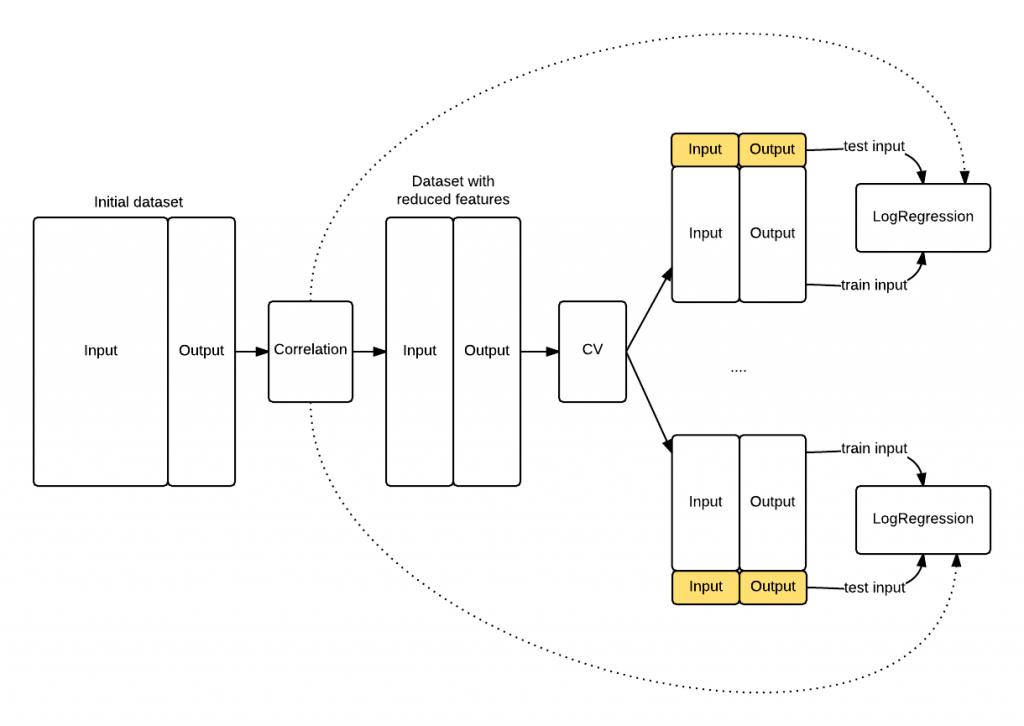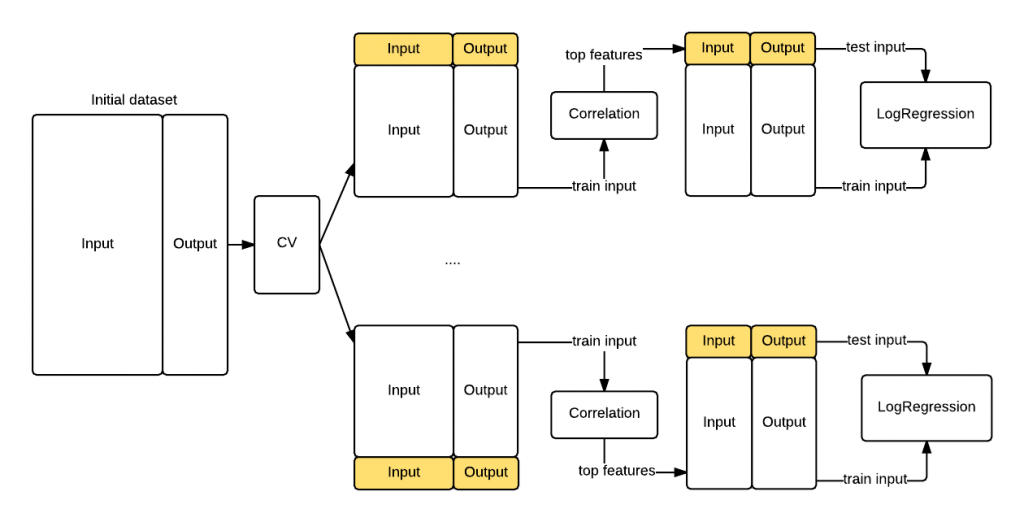Cross Validation done wrong
Cross Validation done wrong
Cross validation is an essential tool in statistical learning 1 to estimate the accuracy of your algorithm. Despite its great power it also exposes some fundamental risk when done wrong which may terribly bias your accuracy estimate.
In this blog post I'll demonstrate - using the Python scikit-learn2framework - how to avoid the biggest and most common pitfall of cross validation in your experiments.
Theory first
Cross validation involves randomly dividing the set of observations intok groups (or folds) of approximately equal size. The first fold is treated as a validation set, and the machine learning algorithm is trained on the remaining k-1 folds. The mean squared error is then computed on the held-out fold. This procedure is repeated k times; each time, a different group of observations is treated as a validation set.
This process results in k estimates of the MSE quantity, namely MSE1, MSE2,...MSEk. The cross validation estimate for the MSE is then computed by simply averaging these values:
This value is an estimate, say MSE^, of the real MSE and our goal is to make this estimate as accurate as possible.
Hands on
Let's now have a look at one of the most typical mistakes when using cross validation. When cross validation is done wrong the result is that MSE^ does not reflect its real value MSE. In other words, you may think that you just found a perfect machine learning algorithm with incredibly low MSE, while in reality you simply wrongly applied CV.
I'll first show you - hands on - a wrong application of cross validation and then we will fix it together. The code is also available as an IPython notebook on github.
Dataset generation
|
1
2
3
4
5
6
7
8
9
|
# Import pandas
import pandas as pd
from pandas import *
# Import scikit-learn
from sklearn.linear_model import LogisticRegression
from sklearn.cross_validation import *
from sklearn.metrics import *
import random
|
To make things simple let's first generate some random data and let's pretend that we want to build a machine learning algorithm to predict the outcome. I'll first generate a dataset of 100 entries. Each entry has10.000 features. But, why so many? Well, to demonstrate our issue I need to generate some correlation between our inputs and output which is purely casual. You'll understand the why later in this post.
|
1
2
3
4
5
6
|
features = np.random.randint(0,10,size=[100,10000])
target = np.random.randint(0,2,size=100)
df = DataFrame(features)
df['target'] = target
df.head()
|
Feature selection
At this point we would like to know what are the features that are more useful to train our predictor. This is called feature selection. The simplest approach to do that is to find which of the 10.000 features in our input is mostly correlated the target. Using pandas this is very easy to do thanks to the corr() function. We run corr() on our dataframe, we order the correlation values, and we pick the first two features.
|
1
2
3
4
5
6
7
8
9
10
|
corr = df.corr()['target'][df.corr()['target'] < 1].abs()
corr.sort(ascending=False)
corr.head()
# 3122 0.392430
# 830 0.367405
# 8374 0.351462
# 9801 0.341806
# 5585 0.336950
# Name: target, dtype: float64
|
Start the training
Great! Out of the 10.000 features we have been able to select two of them, i.e. feature number 3122 and 830 that have a 0.36 and 0.39correlation with the output. At this point let's just drop all the other columns and use these two features to train a simpleLogisticRegression. We then use scikit-learn cross_val_score to compute MSE^ which in this case is equal to 0.33. Pretty good!
|
1
2
3
4
5
6
7
8
9
10
11
12
13
14
15
16
|
features = corr.index[[0,1]].values
training_input = df[features].values
training_output = df['target']
logreg = LogisticRegression()
# scikit learn return the negative value for MSE
# http://stackoverflow.com/questions/21443865/scikit-learn-cross-validation-negative-values-with-mean-squared-error
mse_estimate = -1 * cross_val_score(logreg, training_input, training_output, cv=10, scoring='mean_squared_error')
mse_estimate
# array([ 0.45454545, 0.27272727, 0.27272727, 0.5 , 0.4 ,
# 0.2 , 0.2 , 0.44444444, 0.33333333, 0.22222222])
DataFrame(mse_estimate).mean()
# 0 0.33
# dtype: float64
|
Knowledge leaking
According to the previous estimate we built a system that can predict a random noise target from a random noise input with a MSE of just0.33. The result is, as you can expect, wrong. But why?
The reason is rather counterintuitive and this is why this mistake is so common3. When we applied the feature selection we used information from both the training set and the test sets used for the cross validation, i.e. the correlation values. As a consequence our LogisticRegressionknew information in the test sets that were supposed to be hidden to it. In fact, when you are computing MSEi in the i-th iteration of the cross validation you should be using only the information on the training fold, and nothing should come from the test fold. In our case the model did indeed have information from the test fold, i.e. the top correlated features. I think the term knowledge leaking express this concept fairly well.
The schema that follows shows you how the knowledge leaked into theLogisticRegression because the feature selection has been appliedbefore the cross validation procedure started. The model knows something about the data highlighted in yellow that it shoulnd't know, its top correlated features.
 Figure 1. The exposed knowledge leaking. The LogisticRegression knows the top correlated features of the entire dataset (hence including test folds) because of the initial correlation operation, whilst it should be exposed only to the training fold information.
Figure 1. The exposed knowledge leaking. The LogisticRegression knows the top correlated features of the entire dataset (hence including test folds) because of the initial correlation operation, whilst it should be exposed only to the training fold information.
Proof that our model is biased
To check that we were actually wrong let's do the following:
* Take out a portion of the data set (take_out_set).
* Train the LogisticRegression on the remaining data using the same feature selection we did before.
* After the training is done check the MSE on the take_out_set.
Is the MSE on the take_out_set similar to the MSE^ we estimated with the CV? The answer is no, and we got a much more reasonable MSE of0.53 that is much higher than the MSE^ of 0.33.
|
1
2
3
4
5
6
7
8
9
10
11
12
13
14
15
16
17
18
19
20
21
|
take_out_set = df.ix[random.sample(df.index, 30)]
training_set = df[~(df.isin(take_out_set)).all(axis=1)]
corr = training_set.corr()['target'][df.corr()['target'] < 1].abs()
corr.sort(ascending=False)
features = corr.index[[0,1]].values
training_input = training_set[features].values
training_output = training_set['target']
logreg = LogisticRegression()
logreg.fit(training_input, training_output)
# LogisticRegression(C=1.0, class_weight=None, dual=False, fit_intercept=True,
# intercept_scaling=1, max_iter=100, multi_class='ovr',
# penalty='l2', random_state=None, solver='liblinear', tol=0.0001,
# verbose=0)
y_take_out = logreg.predict(take_out_set[features])
mean_squared_error(take_out_set.target, y_take_out)
# 0.53333333333333333
|
Cross validation done right
In the previous section we have seen that if you inject test knowledge in your model your cross validation procedure will be biased. To avoid this let's compute the features correlation during each cross validation batch. The difference is that now the features correlation will use only the information in the training fold instead of the entire dataset. That's the key insight causing the bias we saw previously. The following graph shows you the revisited procedure. This time we got a realistic MSE^ of0.53 that confirms the data is randomly distributed.
 Figure 2. Revisited cross validation workflow with the correlation step performed for each of the K train/test folds.
Figure 2. Revisited cross validation workflow with the correlation step performed for each of the K train/test folds.
|
1
2
3
4
5
6
7
8
9
10
11
12
13
14
15
16
17
18
19
20
21
22
23
24
25
26
27
28
29
30
31
32
33
34
35
36
37
38
39
40
41
42
43
44
|
kf = KFold(df.shape[0], n_folds=10)
mse = []
fold_count = 0
for train, test in kf:
print("Processing fold %s" % fold_count)
train_fold = df.ix[train]
test_fold = df.ix[test]
# find best features
corr = train_fold.corr()['target'][train_fold.corr()['target'] < 1].abs()
corr.sort(ascending=False)
features = corr.index[[0,1]].values
# Get training examples
train_fold_input = train_fold[features].values
train_fold_output = train_fold['target']
# Fit logistic regression
logreg = LogisticRegression()
logreg.fit(train_fold_input, train_fold_output)
# Check MSE on test set
pred = logreg.predict(test_fold[features])
mse.append(mean_squared_error(test_fold.target, pred))
# Done with the fold
fold_count += 1
print(DataFrame(mse).mean())
# Processing fold 0
# Processing fold 1
# Processing fold 2
# Processing fold 3
# Processing fold 4
# Processing fold 5
# Processing fold 6
# Processing fold 7
# Processing fold 8
# Processing fold 9
DataFrame(mse).mean()
# 0 0.53
# dtype: float64
|
Conclusion
We have seen how doing features selection at the wrong step can terribly bias the MSE estimate of your machine learning algorithm. We have also seen how to correctly apply cross validation by simply moving one step down the features selection such that the knowledge from the test data does not leak in our learning procedure.
If you want to make sure you don't leak info across the train and test set scikit learn gives you additional extra tools like the feature selection pipeline4 and the classes inside the feature selection module5.
Finally, if you want know more about cross validation and its tradeoffs both R. Kohavi6 and Y. Bengio with Y. Grandvalet7 wrote on this topic.
If you liked this post you should consider following me on twitter.
Let me know your comments!
References
- Lecture 1 on cross validation - Statistical Learning @ Stanford
- Scikit-learn framework
- Lecture 2 on cross validation - Statistical Learning @ Stanford
- Scikit-learn feature selection pipeline
- Scikit-learn feature selection modules
- R. Kohavi. A study of cross-validation and bootstrap for accuracy estimation and model selection
- Y. Bengio and Y. Grandvalet. No unbiased estimator of the variance of k-fold cross-validation
Posted onJuly 29, 2015Authormottalrd
10 thoughts on “Cross Validation done wrong”
Gael Varoquauxsays:
To do feature selection inside a cross-validation loop, you should really be using the feature selection objects inside a pipeline:
http://scikit-learn.org/stable/auto_examples/feature_selection/feature_selection_pipeline.html
http://scikit-learn.org/stable/modules/feature_selection.html
That way you can use the model selection tools of scikit-learn:
http://scikit-learn.org/stable/modules/model_evaluation.htmlAnd you are certain that you won't be leaking info across train and test sets.
Cross Validation done wrong的更多相关文章
- 交叉验证(Cross Validation)原理小结
交叉验证是在机器学习建立模型和验证模型参数时常用的办法.交叉验证,顾名思义,就是重复的使用数据,把得到的样本数据进行切分,组合为不同的训练集和测试集,用训练集来训练模型,用测试集来评估模型预测的好坏. ...
- 交叉验证 Cross validation
来源:CSDN: boat_lee 简单交叉验证 hold-out cross validation 从全部训练数据S中随机选择s个样例作为训练集training set,剩余的作为测试集testin ...
- 交叉验证(cross validation)
转自:http://www.vanjor.org/blog/2010/10/cross-validation/ 交叉验证(Cross-Validation): 有时亦称循环估计, 是一种统计学上将数据 ...
- 10折交叉验证(10-fold Cross Validation)与留一法(Leave-One-Out)、分层采样(Stratification)
10折交叉验证 我们构建一个分类器,输入为运动员的身高.体重,输出为其从事的体育项目-体操.田径或篮球. 一旦构建了分类器,我们就可能有兴趣回答类似下述的问题: . 该分类器的精确率怎么样? . 该分 ...
- Cross Validation(交叉验证)
交叉验证(Cross Validation)方法思想 Cross Validation一下简称CV.CV是用来验证分类器性能的一种统计方法. 思想:将原始数据(dataset)进行分组,一部分作为训练 ...
- S折交叉验证(S-fold cross validation)
S折交叉验证(S-fold cross validation) 觉得有用的话,欢迎一起讨论相互学习~Follow Me 仅为个人观点,欢迎讨论 参考文献 https://blog.csdn.net/a ...
- 交叉验证(Cross Validation)简介
参考 交叉验证 交叉验证 (Cross Validation)刘建平 一.训练集 vs. 测试集 在模式识别(pattern recognition)与机器学习(machine lea ...
- cross validation笔记
preface:做实验少不了交叉验证,平时常用from sklearn.cross_validation import train_test_split,用train_test_split()函数将数 ...
- 几种交叉验证(cross validation)方式的比较
模型评价的目的:通过模型评价,我们知道当前训练模型的好坏,泛化能力如何?从而知道是否可以应用在解决问题上,如果不行,那又是哪里出了问题? train_test_split 在分类问题中,我们通常通过对 ...
随机推荐
- 新浪SAE URLRewrite(伪静态、重定向)详解
SAE全称Sina App Engine,真是一个好东西,他有很多优秀的特性,简单来说SAE就是一个简单高效的分布式Web服务开发.运行平台.支持现在常用的 PHP+Mysql 环境,在开发中难免会碰 ...
- php反射应用实例代码
php反射应用示例. 代码如下:<?php function custom(){ } class custom{ public function index(){ } } prin ...
- 从客户端检测到有潜在危险的Request.Form 值【转】
asp.net开发中,经常遇到“从客户端检测到有潜在危险的Request.Form 值”错误提示,很多人给出的解决方案是: 1.web.config文档<system.web>后面加入这一 ...
- Requests:Python HTTP Module学习笔记(二)(转)
在上一篇日志中对Requests做了一个整体的介绍,接来下再介绍一些高级的用法,主要资料还是翻译自官网的文档,如有错漏,欢迎指正. 参考资料:http://docs.python-requests.o ...
- 重命名Oracle数据库的表空间(Renaming a Tablespace)
重命名一个表空间时,Oracle会在数据字典.控制文件和数据文件的头部更新这个表空间名. 注意,重命名一个表空间不会重命名相关联的数据文件. 重命名代码示例如下: SQL> alter tabl ...
- Android--获取App应用程序的大小
Android对这种方法进行了封装,我们没有权限去调用这个方法,所以我们只能通过AIDL,然后利用Java的反射机制去调用系统级的方法. 下面上代码:(注释比较详细) /** * 作用:-----获取 ...
- 先登陆面试再者Tabs标签导航,多次网络请求共享cookie,本地存储cookie
1,index.ng.html: <head> <title>ionic todo example</title> </head> <body n ...
- 15个最好的Bootstrap设计工具推荐
摘要:Bootstrap不单单是一个框架,更确切的说,它改变了整个游戏规则.该框架使得许多应用和网站的设计开发变得简便许多,而且它将大量的HTML框架普及成了产品. Bootstrap是由前Twitt ...
- linux打开端口
客户那边有台服务器同一个局域网中都无法访问,排除lamp环境问题,发现时服务器中的防火墙没有开启80端口.于是去网上搜索了一下,在脚本之家看到一种添加代码的方法 代码如下 复制代码 vi /etc/ ...
- iOSReachability判断网络连接状态
// // NetStateManage.h // // Created by miniu on 15/11/24. // Copyright © 2015年 mini. All rights ...
